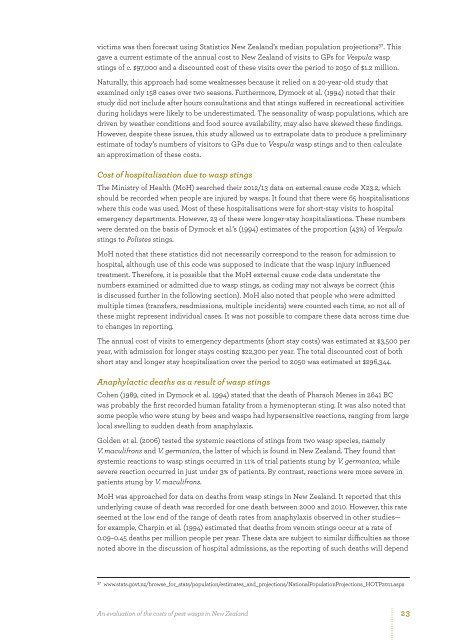evaluation-pest-wasps-nz
evaluation-pest-wasps-nz
evaluation-pest-wasps-nz
Create successful ePaper yourself
Turn your PDF publications into a flip-book with our unique Google optimized e-Paper software.
victims was then forecast using Statistics New Zealand’s median population projections 37 . Thisgave a current estimate of the annual cost to New Zealand of visits to GPs for Vespula <strong>wasps</strong>tings of c. $97,000 and a discounted cost of these visits over the period to 2050 of $1.2 million.Naturally, this approach had some weaknesses because it relied on a 20-year-old study thatexamined only 158 cases over two seasons. Furthermore, Dymock et al. (1994) noted that theirstudy did not include after hours consultations and that stings suffered in recreational activitiesduring holidays were likely to be underestimated. The seasonality of wasp populations, which aredriven by weather conditions and food source availability, may also have skewed these findings.However, despite these issues, this study allowed us to extrapolate data to produce a preliminaryestimate of today’s numbers of visitors to GPs due to Vespula wasp stings and to then calculatean approximation of these costs.Cost of hospitalisation due to wasp stingsThe Ministry of Health (MoH) searched their 2012/13 data on external cause code X23.2, whichshould be recorded when people are injured by <strong>wasps</strong>. It found that there were 65 hospitalisationswhere this code was used. Most of these hospitalisations were for short-stay visits to hospitalemergency departments. However, 23 of these were longer-stay hospitalisations. These numberswere derated on the basis of Dymock et al.’s (1994) estimates of the proportion (43%) of Vespulastings to Polistes stings.MoH noted that these statistics did not necessarily correspond to the reason for admission tohospital, although use of this code was supposed to indicate that the wasp injury influencedtreatment. Therefore, it is possible that the MoH external cause code data understate thenumbers examined or admitted due to wasp stings, as coding may not always be correct (thisis discussed further in the following section). MoH also noted that people who were admittedmultiple times (transfers, readmissions, multiple incidents) were counted each time, so not all ofthese might represent individual cases. It was not possible to compare these data across time dueto changes in reporting.The annual cost of visits to emergency departments (short stay costs) was estimated at $3,500 peryear, with admission for longer stays costing $22,300 per year. The total discounted cost of bothshort stay and longer stay hospitalisation over the period to 2050 was estimated at $296,344.Anaphylactic deaths as a result of wasp stingsCohen (1989, cited in Dymock et al. 1994) stated that the death of Pharaoh Menes in 2641 BCwas probably the first recorded human fatality from a hymenopteran sting. It was also noted thatsome people who were stung by bees and <strong>wasps</strong> had hypersensitive reactions, ranging from largelocal swelling to sudden death from anaphylaxis.Golden et al. (2006) tested the systemic reactions of stings from two wasp species, namelyV. maculifrons and V. germanica, the latter of which is found in New Zealand. They found thatsystemic reactions to wasp stings occurred in 11% of trial patients stung by V. germanica, whilesevere reaction occurred in just under 3% of patients. By contrast, reactions were more severe inpatients stung by V. maculifrons.MoH was approached for data on deaths from wasp stings in New Zealand. It reported that thisunderlying cause of death was recorded for one death between 2000 and 2010. However, this rateseemed at the low end of the range of death rates from anaphylaxis observed in other studies—for example, Charpin et al. (1994) estimated that deaths from venom stings occur at a rate of0.09–0.45 deaths per million people per year. These data are subject to similar difficulties as thosenoted above in the discussion of hospital admissions, as the reporting of such deaths will depend37www.stats.govt.<strong>nz</strong>/browse_for_stats/population/estimates_and_projections/NationalPopulationProjections_HOTP2011.aspxAn <strong>evaluation</strong> of the costs of <strong>pest</strong> <strong>wasps</strong> in New Zealand23


